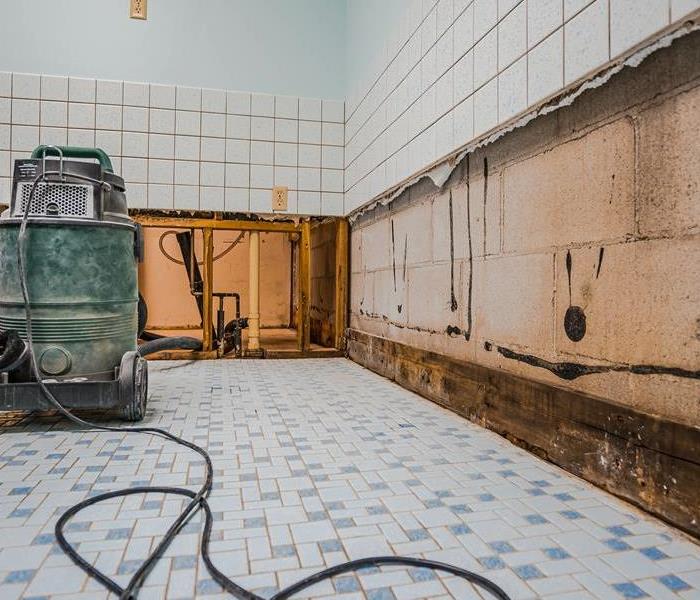The Dangers of Mold in the Workplace Are Worse Than You Think
2/13/2023 (Permalink)
 Shared food spaces or office bathrooms (shown) should be regularly checked for signs of mold or water damage.
Shared food spaces or office bathrooms (shown) should be regularly checked for signs of mold or water damage.
Mold is a common problem in homes and buildings; it thrives in areas with high humidity, such as around pipes, windows, and roof leaks, as well as in recently flooded areas. Mold thrives on cardboard, ceiling tiles, paper, and all wood products. It can grow on a wide variety of materials, including wallpaper, paint, insulation, dust, carpet, drywall, fabric, and upholstery, and spread rapidly. This is especially concerning in buildings that house large numbers of people, such as office complexes, factories, and warehouses.
Mold is a fungus that can quickly spread and become entrenched if not dealt with in a timely fashion. Whether it's a minor case of a runny nose, cough, headache, etc., or a more serious case of aspergillosis, lung irritation, etc., mold can significantly impact one's health. People who have pre-existing conditions like asthma, cystic fibrosis, COPD (Chronic Obstructive Pulmonary Disease), TB (Tuberculosis), sarcoidosis, and others are more likely to get severely affected by mold.
If any type of mold at the workplace poses a health risk to employees, it should be removed as soon as possible.
Adverse Effects of Mold
With a steady increase in population growth and in the number of people working on-site in commercial and industrial buildings, the incidence of mold-related illnesses has increased. Although this issue has been around for a while, few people realize how deadly its consequences are. Workplace mold problems should not be ignored or put at the bottom of the to-do list. This is for the health and safety of everyone in the building and of employees' families at home.
Allergies
Being present in mold-infested buildings can aggravate pre-existing allergies. Symptoms include sneezing; mouth, nose, and throat irritation; runny nose and nasal stuffiness; and red, itchy, or watery eyes. Mold can cause asthma-like symptoms in people who already have allergies, such as coughing, wheezing, or shortness of breath.
Asthma
Mold-related illnesses are also linked to asthma. Constant mold exposure can cause not only symptoms but also illnesses. In people with lung disease, irritating or sensitizing exposure causes airway inflammation. Asthma symptoms include shortness of breath, chest tightness, coughing, and wheezing.
If you suspect a mold issue in your workplace, contact a reputable clean-up firm like SERVPRO. We are highly trained in mold remediation and can quickly restore your workplace to a healthy and productive environment. For additional details, please contact us right away!
Hypersensitivity Pneumonitis
This chronic inflammatory disease, also known as HP, is caused by the sensitization of one's immune system to organic dust when inhaled. This is a serious condition that, if not treated promptly, can result in permanent lung damage. Even though it is often mistaken for regular pneumonia, antibiotics cannot be used to treat it.
Aside from the health risks, mold infestation in the workplace can lead to a variety of other disastrous consequences. Because it often goes unnoticed, it can cause significant damage to the building. They colonize so quickly that, in an unchecked scenario, they can effectively consume building materials such as drywall and wood. This can permanently damage a building's structure. Consequently, the lives of everyone in the area are in grave danger because of the possibility of a building collapse.
Extreme mold infestations can also destroy a building, leaving its owners with no choice but to demolish it. Even if the damage is not as severe, there will be a significant financial loss because tens of thousands of dollars will be spent on repairs.
As the owner, you may also face lawsuits from staff and workers who are infected with mold, which could cost millions of dollars.
According to the NIOSH (National Institute for Occupational Safety and Health), here are some preventive measures to take to avoid a mold infestation:
- To avoid high indoor humidity, use HVAC systems.
- Check buildings for dampness on a regular basis.
- Fix leaking pipes, windows, and roofs as soon as you can.
- After flooding, thoroughly clean and dry the area.
In the event of a mold infestation, the best course of action is to contact a professional remediation service immediately; attempting DIY measures will only worsen the situation. Contact a licensed and trustworthy mold removal company to help you contain the problem quickly and save yourself and your building.
If you suspect a mold problem in your office, contact a professional remediation company like SERVPRO. We specialize in mold removal and can quickly restore your workplace to a safe and healthy state. For more information, please contact us right away!





 24/7 Emergency Service
24/7 Emergency Service